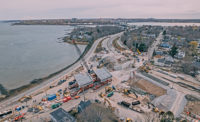Well before construction of the MIT.nano building began last summer, Massachusetts Institute of Technology’s senior project manager Travis Wanat spent months spearheading an effort to determine the prime location for the reported $350-million facility for nanoscience and nanotechnology research. The slightest vibration can wiggle miniscule elements under specialized microscopes and imaging equipment, wreaking havoc on nanoscale experiments. Wanat’s team considered proximity to power lines and mechanical units of abutting buildings as well as subway tunnels and bustling Memorial Drive. In the end, they measured underground magnetic and electromagnetic fields as well as vibrations at five different campus locations. “In order to produce better quality research, we needed to reduce those two factors,” Wanat says.
As it happened, the ideal location for the building—slated to open in 2018—was also one of the hardest possible places to shoehorn a 200,000-sq-ft state-of-the-art facility. Adjacent to MIT’s iconic Great Dome, the parcel sits in the heart of campus. The foundations of abutting structures will deaden research-threatening noises, but those same structures make scheduling construction and delivery vehicles extremely difficult. The 100,000-sq-ft site’s most feasible entry point is a 12-ft-high underpass through a nearby building.
“Every single brick, every single chunk of cement, anything that comes in and out goes through that passageway right there,” says Vladimir Bulović, engineering professor and faculty lead for the project, from his office overlooking the site. “It’s like building a ship in a bottle.”
MIT.nano will be one of the largest commitments to research in the school’s history, according to school officials. More than doubling the campus’s shared fabrication and imaging capabilities, the four-story facility will provide the tools necessary to synthesize and manipulate molecules with cutting-edge speed and accuracy. Built by Turner Construction using the guaranteed maximum price (GMP) delivery method, the project includes a cap-and-beam system and concrete diaphragm wall. Two floors of high-performance interconnected clean rooms will be optimized for energy efficiency, safety and future flexibility. A low-vibration basement for the most delicate nanoscale imaging equipment available is being constructed, along with a monitoring system to automatically increase airflow to maintain scientific integrity.
Designed by local firm Wilson Architects to promote collaboration across disciplines, the facility’s approximately 2,000 researchers will produce innovations that impact everything from computing and communications to energy, health care, manufacturing and even construction materials. For example, research at MIT.nano will use nanotechnology to decrease the size of small cracks in concrete to make buildings stronger. Similarly, research reducing the CO2 emissions necessary to produce concrete will make the material more sustainable. Producing better nano-composition foams could also improve building insulation, while perfecting windows with solar cells embedded inside them could offset energy consumption.
Due to MIT.nano’s central location, the project team had to adjust its schedule around ongoing lab work in surrounding buildings. Prior to construction, school officials met with every department, lab and center impacted by the project. Weekly office hours allow faculty, staff and students to relay their concerns. “It was a delicate balance of trying to accommodate the research but at the same time not stopping [construction],” Wanat says.
The central location puts the project team under the microscope as well. At any given moment, Bulović says, dozens of people are pressed against windows “observing and rooting for the pipe to go in; we are a very technical campus, so we appreciate the marvel of what’s being done here.” Wanat joked that there’s “always thousands of superintendents watching you.”
Beginning in June 2014, those onlookers witnessed a year-long enabling phase that required the largest utility project in MIT history, Wanat says. Crews reconfigured and enhanced utility lines running through the main campus. Additional chilled water lines were extended from the nearby central utility plant. Upgraded electrical, high-voltage system, gas, water, bio-protection and compressed air lines also extend to the site. In some cases, systems untouched for 60 to 100 years received updates. Workers encountered leaky valves and decayed pipes nearly every time the team put a shovel in the ground, adds Wanat.
Another unexpected challenge arose after demolition of the existing structure on the site known as Building 12 began in December 2014. The project team discovered mercury in the drainage system under the slab of the building built in 1943 for the chemical engineering department. At the time, mercury was simply poured down the drain after an experiment. The team discovered 2,203 lineal ft of polluted piping. The concrete-encased pipes snaked throughout the site.
After spending six months figuring out how to best remove and discard the mercury, the team spent another two months implementing their plan. Working on 2-ft sections of pipe at a time, crews hand-chipped concrete around the sections to avoid piercing them and spilling mercury. Then, they drilled two holes on top of the pipe about 2 ft apart. They sprayed foam in the holes that kept the mercury at bay before cutting the pipe into sections. After removing the foam from one end of a section, they drained the mercury into a special container and tested the pipe to ensure it was clean. “We had two or three crews going the whole time,” says Peter Johnson, Turner project executive. The contractor recovered lost time resulting from the complex process by working overtime on pre-trenching, mass excavation and foundation work.
Excavation wrapped up in January, and foundation work finished a month later. The 40,000-sq-ft of slurry wall designed by local structural engineer LeMessurier serves as another barrier from noise. It also allowed architects to maximize the site’s space without damaging the foundations of abutting buildings. Just to be safe, however, the team installed seismographs in the surrounding buildings to measure vibration caused by construction. The monitors notify the team if structural elements are being compromised.
An 8,000-sq-ft concrete “bathtub” in the basement will protect eight high-performance imaging suites against vibrations and electromagnetic currents. Reinforced by epoxy-coated rebar, the 4-ft-thick tub’s 1,000 cu yds of concrete were placed in a single eight-hour stretch. Bulović says orchestrating the 90 trucks to systematically deliver concrete was “an incredible feat of engineering in itself.”
Specially designed plinths, or inertia blocks, to be installed under the microscopes, will also defend against stray currents and vibrations. These 20-ton concrete pads actively monitor and absorb subterranean vibrations and can be elevated to further isolate the equipment from disruptions. “You are basically putting it on springs,” says Samir Srouji, a principal at Wilson Architects.
Flexibility was also designed into the imaging suites and clean rooms to accommodate future technologies. For example, each clean room includes an approximately 2-plus-ft-high cut-out in the ceiling to accommodate taller, high-powered microscopes.
Stringent protocols ensure that the clean rooms are sterile from the start, rather than building the rooms traditionally and then cleaning them after the fact. Once clean-room construction gets underway in a few months, every worker and tradesman will wear special suits, including protectors over their boots, at all times, says Johnson. Every tool will be new or cleaned before it enters the site. Much of the 35.6 miles of piping is being prefabricated in an offsite clean room so it can be packaged and delivered to the site ready for installation.
The building requires highly filtered air and regulated temperatures in the clean rooms to produce quality research. The mechanical design by Bard, Rao + Athanas Consulting Engineers LLC calls for ventilation systems located in dedicated floors known as plenums above each level of clean rooms. Ranging in size from 9,000 cfm to 14,000 cfm, 64 air-handling units in the plenums receive fresh air from the penthouse before pumping it into the clean rooms.
While the average air changes per hour in clean rooms are typically 350, MIT’s current design strategy aims to significantly reduce its air changes per hour to save energy. Controls in the building automation system will measure real-time environmental conditions of the clean room, including occupancy sensors that adjust air changes based on actual environmental conditions. Particle counters and variable air volume dampers will also be implemented. “These three controls will work together to identify if the air change rate can be reduced based on the classification of the particular bay and the actual particles and or occupancy in that same bay,” Wanat says.
In addition to these energy savings efforts, a heat-recovery system on the exhaust vents will reduce energy consumption and help the building track toward LEED Gold certification.
Workers completed erection of 2,101 tons of structural steel in May, the same month MIT celebrated the 100-year anniversary of moving its campus from Boston to Cambridge. The Cambridge campus revolutionized the construction industry by using an innovative material first conceived and tested at MIT: reinforced concrete. Continuing that tradition of innovation, Bulović says “MIT.nano will be the first building for the next 100 years of MIT. And it’s a fitting example of redefining what technology will be for the 21st century.”










Post a comment to this article
Report Abusive Comment